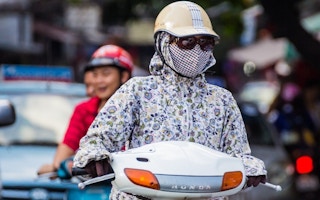Vietnam’s environment ministry has proposed measures aimed at curbing urban air pollution that could take effect next month, Vietnamese media outlets reported this week.
To continue reading, subscribe to Eco‑Business.
There's something for everyone. We offer a range of subscription plans.
- Access our stories and receive our Insights Weekly newsletter with the free EB Member plan.
- Unlock unlimited access to our content and archive with EB Circle.
- Publish your content with EB Premium.
The new directive—the smog-choked nation’s first potential step towards cleaner air—will task cities and provinces plagued by filthy air with the responsibility of devising and implementing plans to tackle a rising problem that kills more Vietnamese than motorbike accidents each year.
The decree, which has been sent to other government agencies for feedback, reportedly calls for sweeping changes in the transport and construction sectors as well as better monitoring of pollution levels and sources, involving efforts from the ministries of transport, construction and health. But will it go far enough to fix the country’s sources of air pollution?
Over the past decade, Vietnam’s air quality has steadily deteriorated. A study released earlier this year declared its capital Hanoi the seventh-most polluted city globally, placing it ahead of Beijing, the capital with the world’s dirtiest air just a few years ago.
But the congested urban jungle that is Ho Chi Minh City is not faring much better. In 2018, both the southern metropolis and Hanoi ranked among the 15 most polluted cities in Southeast Asia, a region frequently haunted by suffocating air due to heavy traffic, coal combustion and the burning of peatland and forests to make way for oil palms.
The air pollutant that concerns Vietnam the most—and one that is particularly harmful to human health—is fine particulate matter, or PM2.5. Small enough to penetrate deep into the lungs and cardiovascular system, these particles can cause diseases such as stroke, heart disease, lung cancer, and respiratory infections.
In 2019, Hanoi saw only eight days with PM2.5 levels lower than the national standard of 50 micrograms per cubic metre, while Ho Chi Minh City recorded 36 days where its population of 9 million was not exposed to dangerous air. This is even though Vietnam’s standard allows PM2.5 levels double what the World Health Organisation deems safe.
Around 60,000 deaths in Vietnam were linked to air pollution in 2016. Dirty air costs the nation about 5 per cent of GDP per year, according to the World Bank.
What about heavy industry, coal and solid biomass cooking stoves?
Under the new directive, this could change. It will stipulate that local authorities expand public transport networks and incentivise purchases of electric cars to get gas-guzzling motorbikes and vehicles off the roads and limit prolonged traffic congestion.
On high-pollution days, cities will be required to cut traffic flows into urban centres, while older and highly polluting vehicles roaming Vietnam’s streets are expected to be banned. Meanwhile, the construction ministry is set to issue regulations to reduce the release of dust from construction sites.
Transportation is indeed a major contributor to Vietnam’s pollution. The country now has 3.6 million cars and 58 million motorbikes, many of them old and equipped with limited emission control technology. Construction sites are another big issue, with trucks that ship in sand and cement creating perpetual dust storms.
But so are old industrial sites, cement and steel manufacturers as well as Vietnam’s coal boom, which is choking the nation’s northern parts. Adding to this are solid biomass cooking stoves used by hundreds of thousands of city dwellers and the burning of rice fields after harvest. It has not been announced whether the government plans to rein in such polluters as it ramps up air quality monitoring.
Nor has there been mention of poor urban planning, which exacerbates many existing pollution problems. In Vietnam’s densely packed cities, factories and never-ending traffic jams belch out exhaust smoke that mingles with the hot, moisture-laden air, forming a toxic brew that gets trapped among high-rise structures.
As shopping malls and office buildings continue to mushroom, they aggravate the situation while hampering the build-out of public transport. Relocating universities, hospitals and industrial facilities to the outskirts of Vietnam’s cities would help create open and green spaces, but no such strategies appear to be in the making at this point.
It has also been suggested that Vietnam could implement pollutant pricing as well as a carbon pricing scheme, which would help the Southeast Asian country live up to its commitments to keep global heating in check. The very first step, however, should be to scrap the annual fossil fuel subsidy of US$612 million.
Another approach is to equip citizens with real-time information on pollution levels to help them make critical choices, such as whether to venture outside on smoggy days. Vietnam does not disseminate the real-time air quality data it generates in a fully transparent manner, reveals a new study by American non-profit OpenAQ. Besides hampering individual decisions, this prevents civil society groups from holding policymakers and industries to account.
Questions have also been raised on whether public access to third-party data was suppressed. Last October, a mobile app that provides users with real-time air quality data went out of commission in Vietnam after seriously unhealthy air pollution levels hit Hanoi. The operator of the app, Switzerland and United States-based air quality monitoring firm IQAir, claimed it was subject to a coordinated cyber-attack from unknown sources.
The capital was momentarily ranked as the world’s most polluted city, with air quality readings rising to “hazardous”. This means that breathing the air in the city can cause serious long-term health issues.
Eco-Business has reached out to the country’s Ministry of Natural Resources and Environment for comment.
Finally, the role of coal, the most polluting of fossil fuels, in Vietnam’s energy mix should be relooked as part of its air pollution strategy. Despite being Southeast Asia’s hottest renewable energy market, the country’s coal consumption has tripled in the last 10 years, and London-headquartered think tank Fitch Solutions forecasts that coal power generation will keep increasing rapidly and dominate the power sector expansion, making up 50.5 per cent of the electricity mix by 2028. Not only will this hamstring efforts towards more breathable air, it is incompatible with a “just recovery” from the coronavirus pandemic that many global experts are calling for.











